University Healthcare Quality and Safety Report: Analysis and Findings
VerifiedAdded on 2020/03/07
|10
|2349
|178
Report
AI Summary
This report delves into the multifaceted dimensions of quality and safety within the healthcare sector. It begins by defining healthcare quality and elucidating the core principles of Total Quality Management (TQM) and Continuous Quality Improvement (CQI), emphasizing their significance in achieving optimal patient outcomes. The report then transitions to patient safety, exploring its definition and importance, along with strategies like crew resource management and computerized diagnosis entry. The Australian National Safety and Quality Health Service (NSQHS) Standards are examined, detailing each standard and their role in safeguarding patients and enhancing care quality. Furthermore, it identifies key organizational factors, such as integrated delivery systems and a systems approach, that either support or hinder effective quality management. The concept of safety culture in healthcare is explored, including its measurement and the impact of a poor safety culture on both healthcare professionals and patients. The report concludes by highlighting the need for proactive safety systems and continuous improvement to minimize risks and ensure high-quality healthcare delivery.
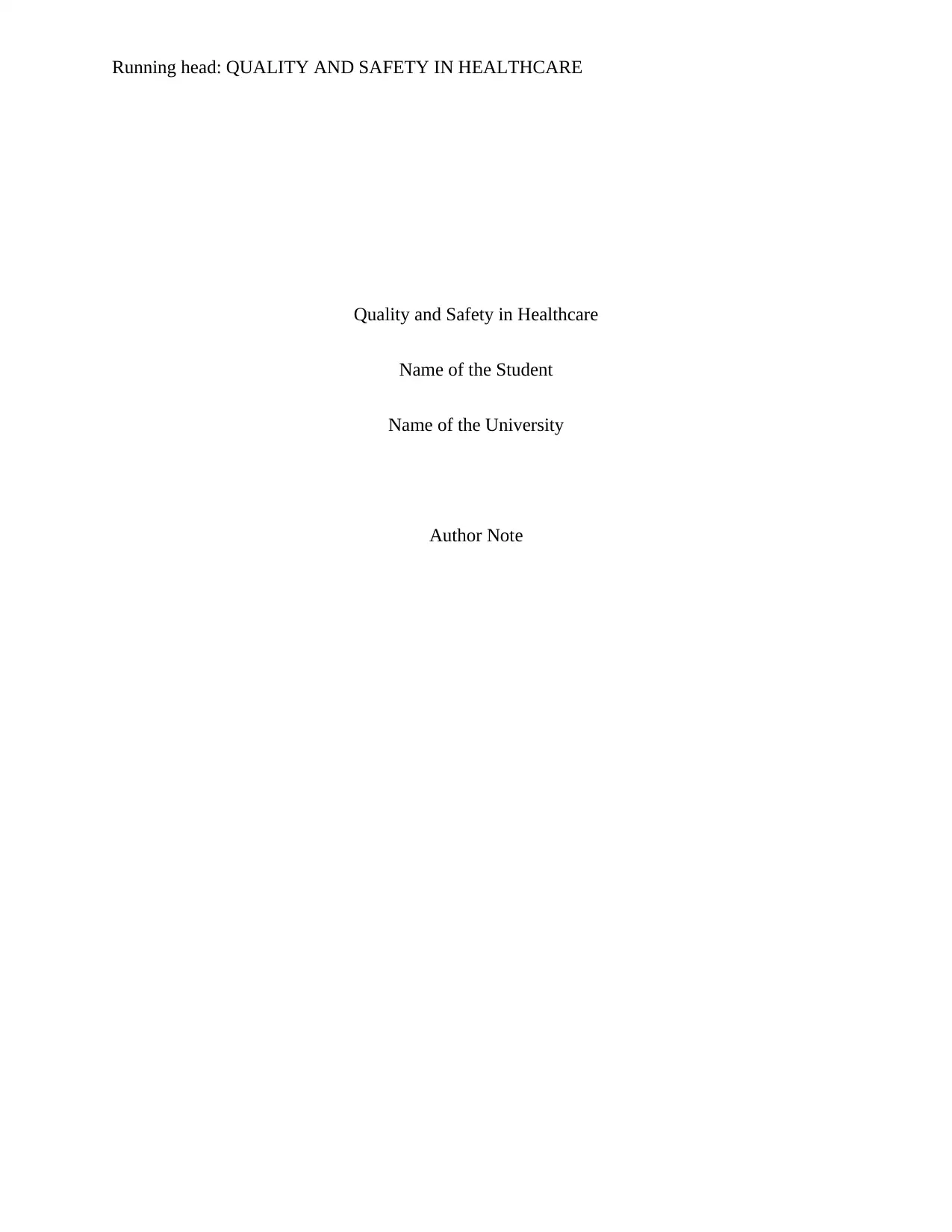
Running head: QUALITY AND SAFETY IN HEALTHCARE
Quality and Safety in Healthcare
Name of the Student
Name of the University
Author Note
Quality and Safety in Healthcare
Name of the Student
Name of the University
Author Note
Paraphrase This Document
Need a fresh take? Get an instant paraphrase of this document with our AI Paraphraser
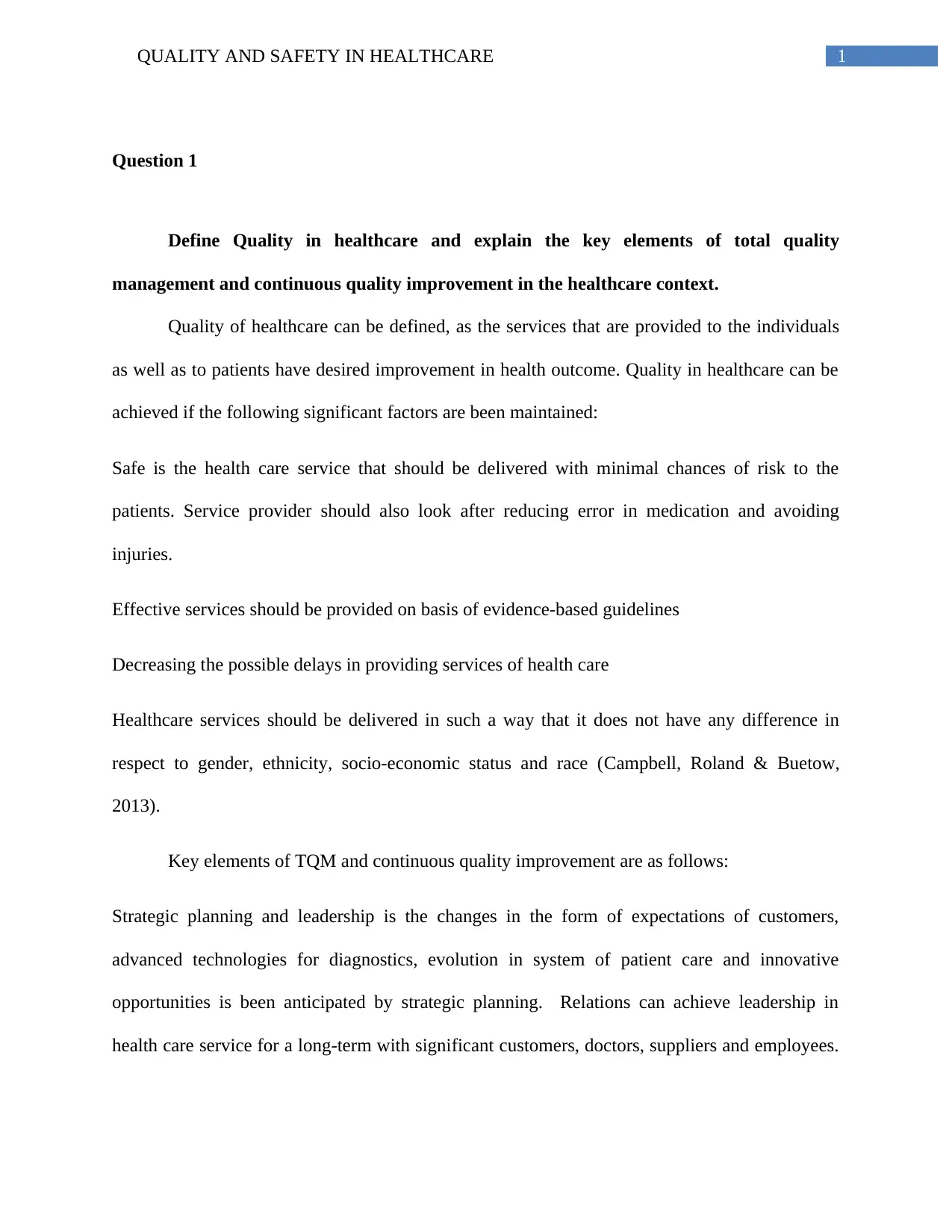
1QUALITY AND SAFETY IN HEALTHCARE
Question 1
Define Quality in healthcare and explain the key elements of total quality
management and continuous quality improvement in the healthcare context.
Quality of healthcare can be defined, as the services that are provided to the individuals
as well as to patients have desired improvement in health outcome. Quality in healthcare can be
achieved if the following significant factors are been maintained:
Safe is the health care service that should be delivered with minimal chances of risk to the
patients. Service provider should also look after reducing error in medication and avoiding
injuries.
Effective services should be provided on basis of evidence-based guidelines
Decreasing the possible delays in providing services of health care
Healthcare services should be delivered in such a way that it does not have any difference in
respect to gender, ethnicity, socio-economic status and race (Campbell, Roland & Buetow,
2013).
Key elements of TQM and continuous quality improvement are as follows:
Strategic planning and leadership is the changes in the form of expectations of customers,
advanced technologies for diagnostics, evolution in system of patient care and innovative
opportunities is been anticipated by strategic planning. Relations can achieve leadership in
health care service for a long-term with significant customers, doctors, suppliers and employees.
Question 1
Define Quality in healthcare and explain the key elements of total quality
management and continuous quality improvement in the healthcare context.
Quality of healthcare can be defined, as the services that are provided to the individuals
as well as to patients have desired improvement in health outcome. Quality in healthcare can be
achieved if the following significant factors are been maintained:
Safe is the health care service that should be delivered with minimal chances of risk to the
patients. Service provider should also look after reducing error in medication and avoiding
injuries.
Effective services should be provided on basis of evidence-based guidelines
Decreasing the possible delays in providing services of health care
Healthcare services should be delivered in such a way that it does not have any difference in
respect to gender, ethnicity, socio-economic status and race (Campbell, Roland & Buetow,
2013).
Key elements of TQM and continuous quality improvement are as follows:
Strategic planning and leadership is the changes in the form of expectations of customers,
advanced technologies for diagnostics, evolution in system of patient care and innovative
opportunities is been anticipated by strategic planning. Relations can achieve leadership in
health care service for a long-term with significant customers, doctors, suppliers and employees.
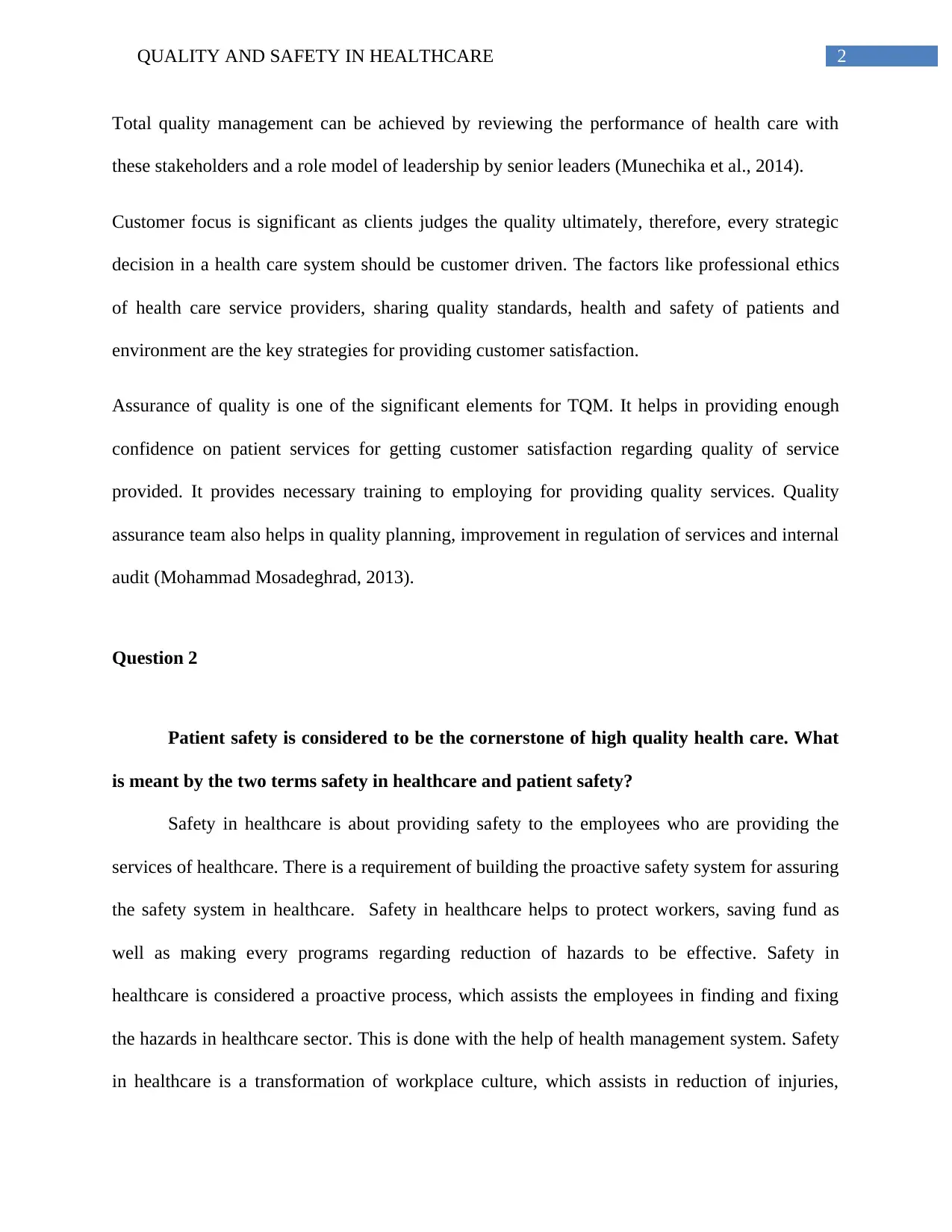
2QUALITY AND SAFETY IN HEALTHCARE
Total quality management can be achieved by reviewing the performance of health care with
these stakeholders and a role model of leadership by senior leaders (Munechika et al., 2014).
Customer focus is significant as clients judges the quality ultimately, therefore, every strategic
decision in a health care system should be customer driven. The factors like professional ethics
of health care service providers, sharing quality standards, health and safety of patients and
environment are the key strategies for providing customer satisfaction.
Assurance of quality is one of the significant elements for TQM. It helps in providing enough
confidence on patient services for getting customer satisfaction regarding quality of service
provided. It provides necessary training to employing for providing quality services. Quality
assurance team also helps in quality planning, improvement in regulation of services and internal
audit (Mohammad Mosadeghrad, 2013).
Question 2
Patient safety is considered to be the cornerstone of high quality health care. What
is meant by the two terms safety in healthcare and patient safety?
Safety in healthcare is about providing safety to the employees who are providing the
services of healthcare. There is a requirement of building the proactive safety system for assuring
the safety system in healthcare. Safety in healthcare helps to protect workers, saving fund as
well as making every programs regarding reduction of hazards to be effective. Safety in
healthcare is considered a proactive process, which assists the employees in finding and fixing
the hazards in healthcare sector. This is done with the help of health management system. Safety
in healthcare is a transformation of workplace culture, which assists in reduction of injuries,
Total quality management can be achieved by reviewing the performance of health care with
these stakeholders and a role model of leadership by senior leaders (Munechika et al., 2014).
Customer focus is significant as clients judges the quality ultimately, therefore, every strategic
decision in a health care system should be customer driven. The factors like professional ethics
of health care service providers, sharing quality standards, health and safety of patients and
environment are the key strategies for providing customer satisfaction.
Assurance of quality is one of the significant elements for TQM. It helps in providing enough
confidence on patient services for getting customer satisfaction regarding quality of service
provided. It provides necessary training to employing for providing quality services. Quality
assurance team also helps in quality planning, improvement in regulation of services and internal
audit (Mohammad Mosadeghrad, 2013).
Question 2
Patient safety is considered to be the cornerstone of high quality health care. What
is meant by the two terms safety in healthcare and patient safety?
Safety in healthcare is about providing safety to the employees who are providing the
services of healthcare. There is a requirement of building the proactive safety system for assuring
the safety system in healthcare. Safety in healthcare helps to protect workers, saving fund as
well as making every programs regarding reduction of hazards to be effective. Safety in
healthcare is considered a proactive process, which assists the employees in finding and fixing
the hazards in healthcare sector. This is done with the help of health management system. Safety
in healthcare is a transformation of workplace culture, which assists in reduction of injuries,
⊘ This is a preview!⊘
Do you want full access?
Subscribe today to unlock all pages.

Trusted by 1+ million students worldwide
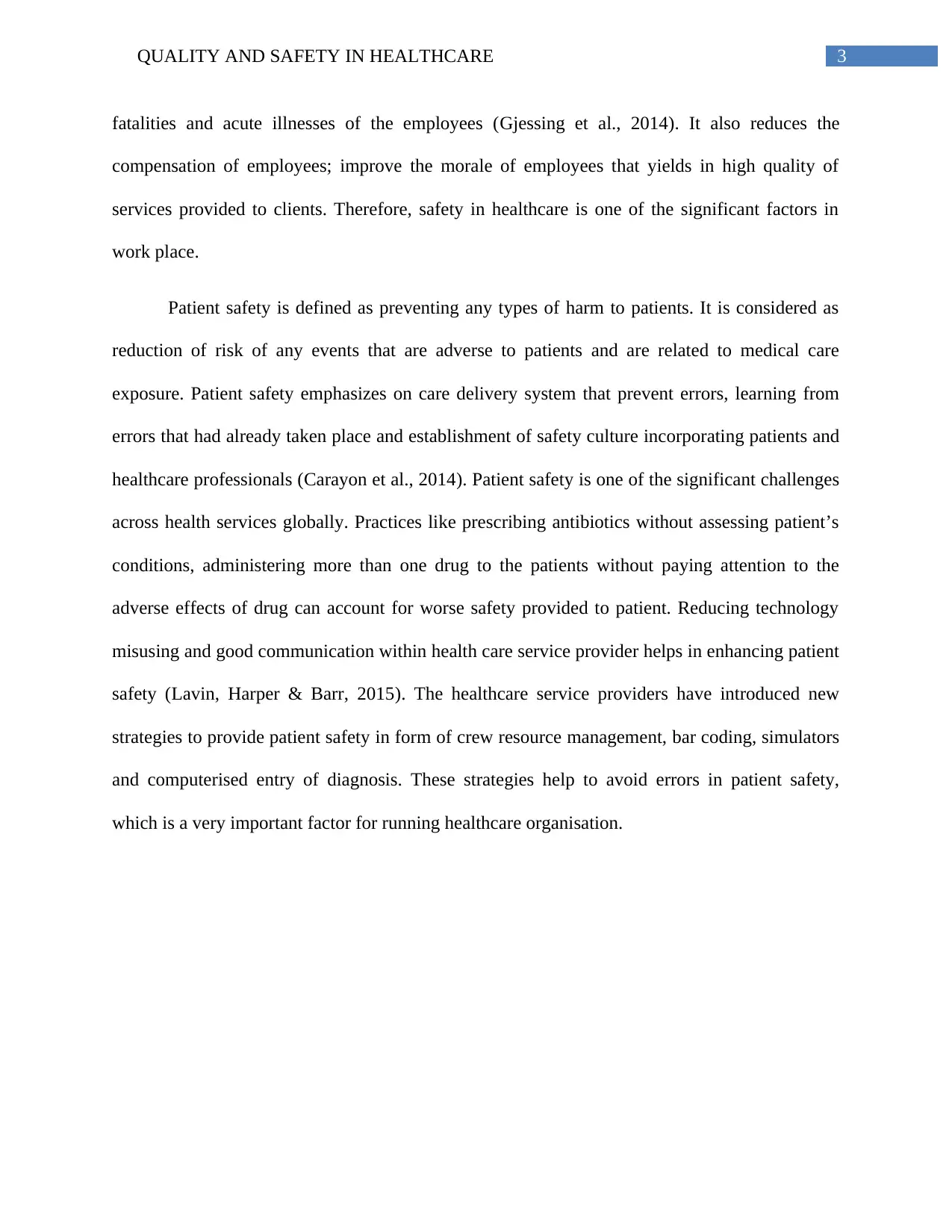
3QUALITY AND SAFETY IN HEALTHCARE
fatalities and acute illnesses of the employees (Gjessing et al., 2014). It also reduces the
compensation of employees; improve the morale of employees that yields in high quality of
services provided to clients. Therefore, safety in healthcare is one of the significant factors in
work place.
Patient safety is defined as preventing any types of harm to patients. It is considered as
reduction of risk of any events that are adverse to patients and are related to medical care
exposure. Patient safety emphasizes on care delivery system that prevent errors, learning from
errors that had already taken place and establishment of safety culture incorporating patients and
healthcare professionals (Carayon et al., 2014). Patient safety is one of the significant challenges
across health services globally. Practices like prescribing antibiotics without assessing patient’s
conditions, administering more than one drug to the patients without paying attention to the
adverse effects of drug can account for worse safety provided to patient. Reducing technology
misusing and good communication within health care service provider helps in enhancing patient
safety (Lavin, Harper & Barr, 2015). The healthcare service providers have introduced new
strategies to provide patient safety in form of crew resource management, bar coding, simulators
and computerised entry of diagnosis. These strategies help to avoid errors in patient safety,
which is a very important factor for running healthcare organisation.
fatalities and acute illnesses of the employees (Gjessing et al., 2014). It also reduces the
compensation of employees; improve the morale of employees that yields in high quality of
services provided to clients. Therefore, safety in healthcare is one of the significant factors in
work place.
Patient safety is defined as preventing any types of harm to patients. It is considered as
reduction of risk of any events that are adverse to patients and are related to medical care
exposure. Patient safety emphasizes on care delivery system that prevent errors, learning from
errors that had already taken place and establishment of safety culture incorporating patients and
healthcare professionals (Carayon et al., 2014). Patient safety is one of the significant challenges
across health services globally. Practices like prescribing antibiotics without assessing patient’s
conditions, administering more than one drug to the patients without paying attention to the
adverse effects of drug can account for worse safety provided to patient. Reducing technology
misusing and good communication within health care service provider helps in enhancing patient
safety (Lavin, Harper & Barr, 2015). The healthcare service providers have introduced new
strategies to provide patient safety in form of crew resource management, bar coding, simulators
and computerised entry of diagnosis. These strategies help to avoid errors in patient safety,
which is a very important factor for running healthcare organisation.
Paraphrase This Document
Need a fresh take? Get an instant paraphrase of this document with our AI Paraphraser
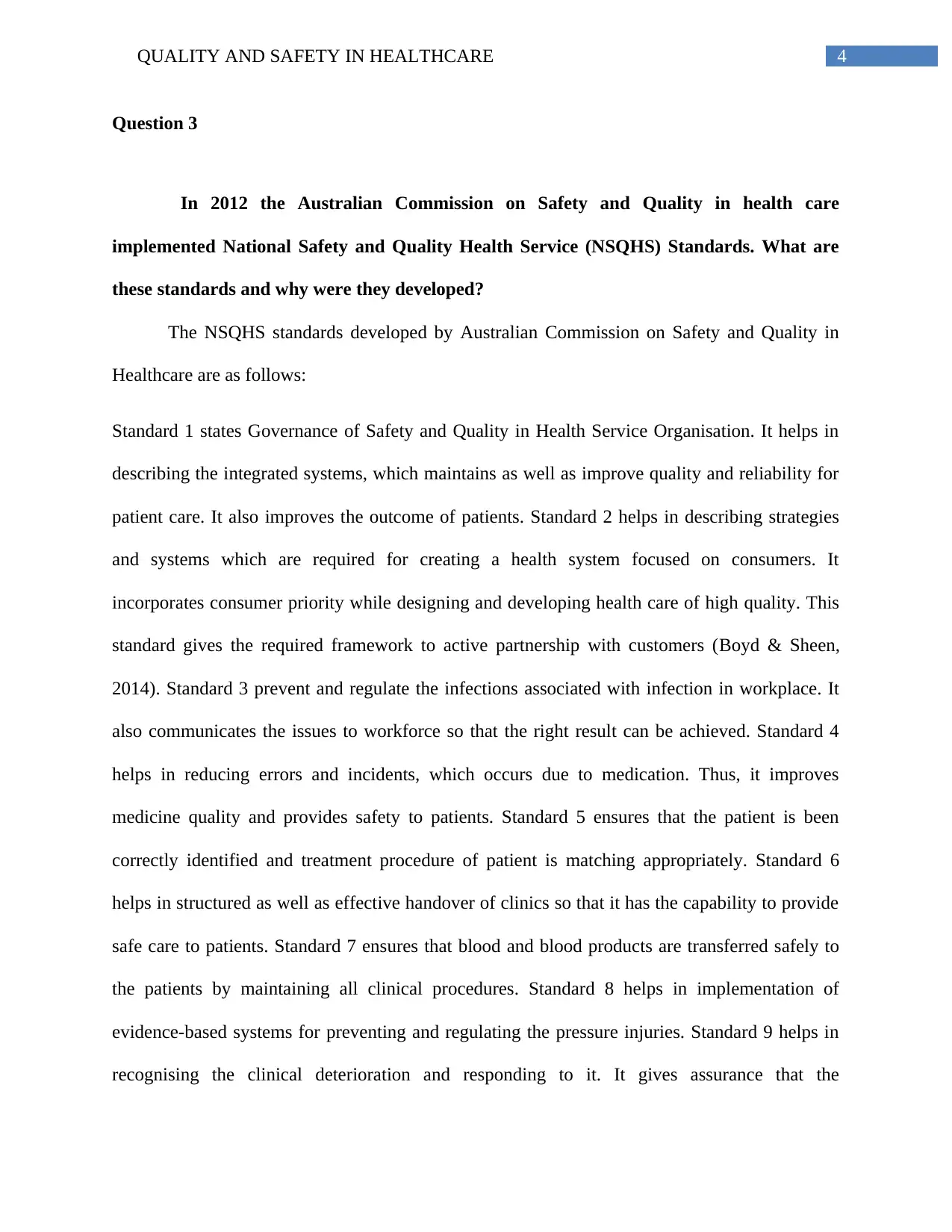
4QUALITY AND SAFETY IN HEALTHCARE
Question 3
In 2012 the Australian Commission on Safety and Quality in health care
implemented National Safety and Quality Health Service (NSQHS) Standards. What are
these standards and why were they developed?
The NSQHS standards developed by Australian Commission on Safety and Quality in
Healthcare are as follows:
Standard 1 states Governance of Safety and Quality in Health Service Organisation. It helps in
describing the integrated systems, which maintains as well as improve quality and reliability for
patient care. It also improves the outcome of patients. Standard 2 helps in describing strategies
and systems which are required for creating a health system focused on consumers. It
incorporates consumer priority while designing and developing health care of high quality. This
standard gives the required framework to active partnership with customers (Boyd & Sheen,
2014). Standard 3 prevent and regulate the infections associated with infection in workplace. It
also communicates the issues to workforce so that the right result can be achieved. Standard 4
helps in reducing errors and incidents, which occurs due to medication. Thus, it improves
medicine quality and provides safety to patients. Standard 5 ensures that the patient is been
correctly identified and treatment procedure of patient is matching appropriately. Standard 6
helps in structured as well as effective handover of clinics so that it has the capability to provide
safe care to patients. Standard 7 ensures that blood and blood products are transferred safely to
the patients by maintaining all clinical procedures. Standard 8 helps in implementation of
evidence-based systems for preventing and regulating the pressure injuries. Standard 9 helps in
recognising the clinical deterioration and responding to it. It gives assurance that the
Question 3
In 2012 the Australian Commission on Safety and Quality in health care
implemented National Safety and Quality Health Service (NSQHS) Standards. What are
these standards and why were they developed?
The NSQHS standards developed by Australian Commission on Safety and Quality in
Healthcare are as follows:
Standard 1 states Governance of Safety and Quality in Health Service Organisation. It helps in
describing the integrated systems, which maintains as well as improve quality and reliability for
patient care. It also improves the outcome of patients. Standard 2 helps in describing strategies
and systems which are required for creating a health system focused on consumers. It
incorporates consumer priority while designing and developing health care of high quality. This
standard gives the required framework to active partnership with customers (Boyd & Sheen,
2014). Standard 3 prevent and regulate the infections associated with infection in workplace. It
also communicates the issues to workforce so that the right result can be achieved. Standard 4
helps in reducing errors and incidents, which occurs due to medication. Thus, it improves
medicine quality and provides safety to patients. Standard 5 ensures that the patient is been
correctly identified and treatment procedure of patient is matching appropriately. Standard 6
helps in structured as well as effective handover of clinics so that it has the capability to provide
safe care to patients. Standard 7 ensures that blood and blood products are transferred safely to
the patients by maintaining all clinical procedures. Standard 8 helps in implementation of
evidence-based systems for preventing and regulating the pressure injuries. Standard 9 helps in
recognising the clinical deterioration and responding to it. It gives assurance that the
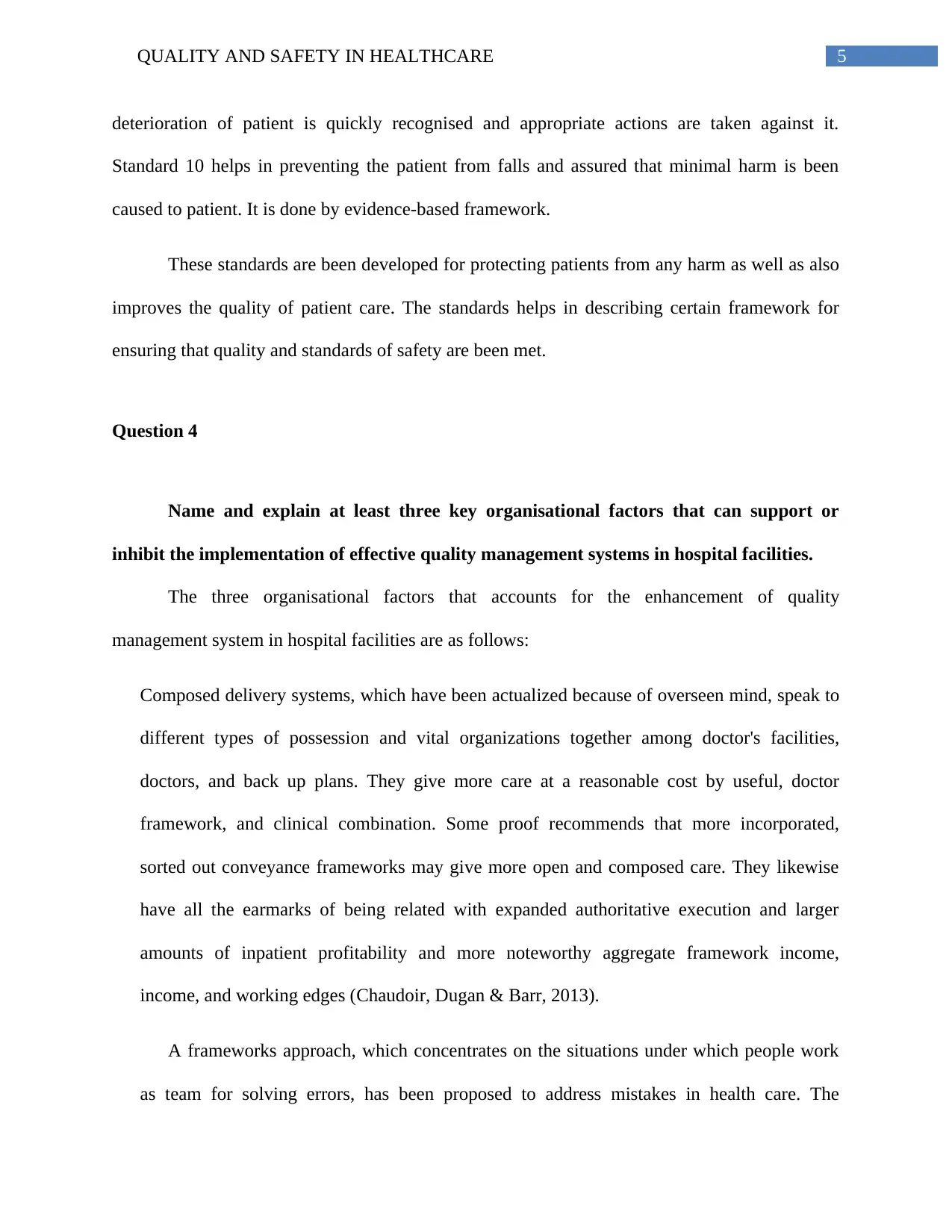
5QUALITY AND SAFETY IN HEALTHCARE
deterioration of patient is quickly recognised and appropriate actions are taken against it.
Standard 10 helps in preventing the patient from falls and assured that minimal harm is been
caused to patient. It is done by evidence-based framework.
These standards are been developed for protecting patients from any harm as well as also
improves the quality of patient care. The standards helps in describing certain framework for
ensuring that quality and standards of safety are been met.
Question 4
Name and explain at least three key organisational factors that can support or
inhibit the implementation of effective quality management systems in hospital facilities.
The three organisational factors that accounts for the enhancement of quality
management system in hospital facilities are as follows:
Composed delivery systems, which have been actualized because of overseen mind, speak to
different types of possession and vital organizations together among doctor's facilities,
doctors, and back up plans. They give more care at a reasonable cost by useful, doctor
framework, and clinical combination. Some proof recommends that more incorporated,
sorted out conveyance frameworks may give more open and composed care. They likewise
have all the earmarks of being related with expanded authoritative execution and larger
amounts of inpatient profitability and more noteworthy aggregate framework income,
income, and working edges (Chaudoir, Dugan & Barr, 2013).
A frameworks approach, which concentrates on the situations under which people work
as team for solving errors, has been proposed to address mistakes in health care. The
deterioration of patient is quickly recognised and appropriate actions are taken against it.
Standard 10 helps in preventing the patient from falls and assured that minimal harm is been
caused to patient. It is done by evidence-based framework.
These standards are been developed for protecting patients from any harm as well as also
improves the quality of patient care. The standards helps in describing certain framework for
ensuring that quality and standards of safety are been met.
Question 4
Name and explain at least three key organisational factors that can support or
inhibit the implementation of effective quality management systems in hospital facilities.
The three organisational factors that accounts for the enhancement of quality
management system in hospital facilities are as follows:
Composed delivery systems, which have been actualized because of overseen mind, speak to
different types of possession and vital organizations together among doctor's facilities,
doctors, and back up plans. They give more care at a reasonable cost by useful, doctor
framework, and clinical combination. Some proof recommends that more incorporated,
sorted out conveyance frameworks may give more open and composed care. They likewise
have all the earmarks of being related with expanded authoritative execution and larger
amounts of inpatient profitability and more noteworthy aggregate framework income,
income, and working edges (Chaudoir, Dugan & Barr, 2013).
A frameworks approach, which concentrates on the situations under which people work
as team for solving errors, has been proposed to address mistakes in health care. The
⊘ This is a preview!⊘
Do you want full access?
Subscribe today to unlock all pages.

Trusted by 1+ million students worldwide
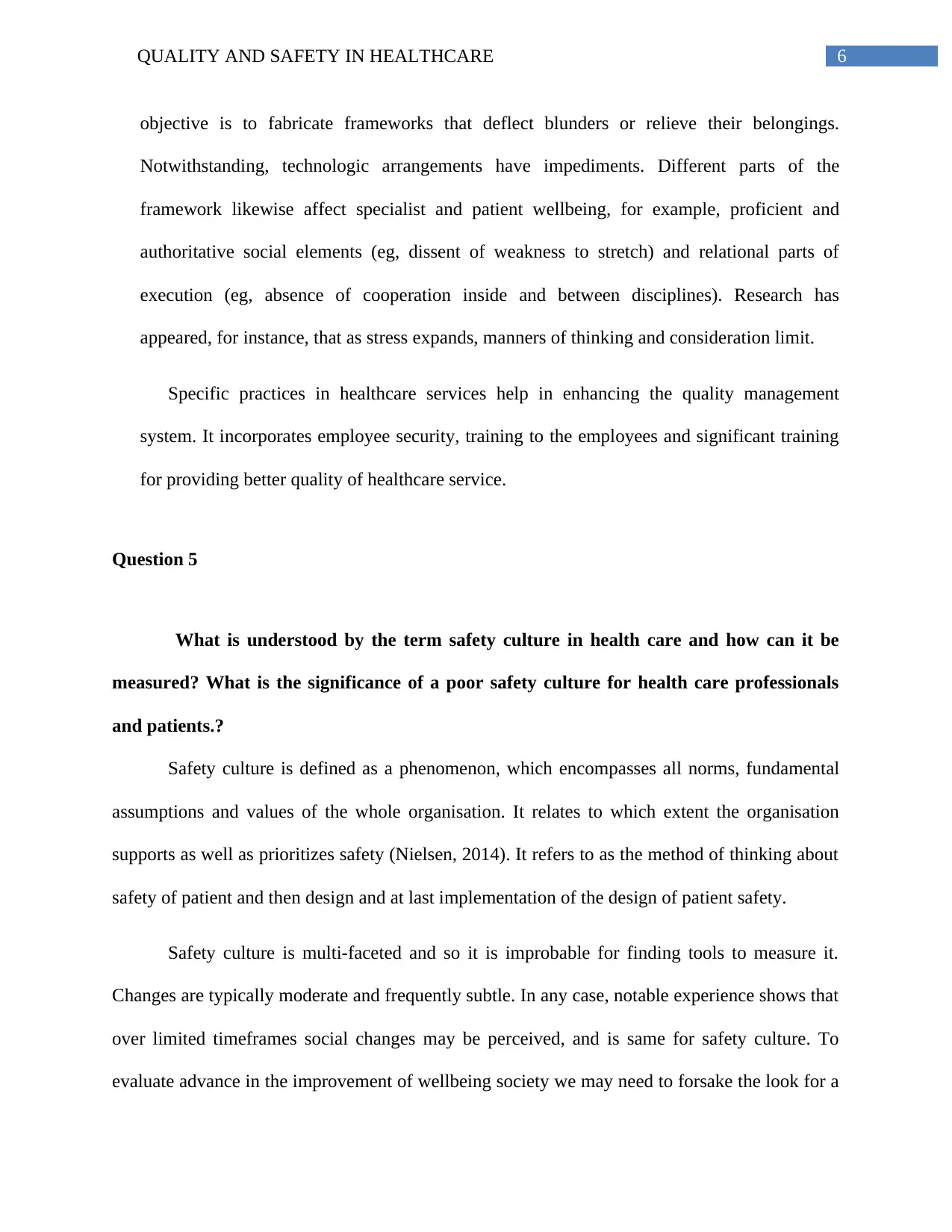
6QUALITY AND SAFETY IN HEALTHCARE
objective is to fabricate frameworks that deflect blunders or relieve their belongings.
Notwithstanding, technologic arrangements have impediments. Different parts of the
framework likewise affect specialist and patient wellbeing, for example, proficient and
authoritative social elements (eg, dissent of weakness to stretch) and relational parts of
execution (eg, absence of cooperation inside and between disciplines). Research has
appeared, for instance, that as stress expands, manners of thinking and consideration limit.
Specific practices in healthcare services help in enhancing the quality management
system. It incorporates employee security, training to the employees and significant training
for providing better quality of healthcare service.
Question 5
What is understood by the term safety culture in health care and how can it be
measured? What is the significance of a poor safety culture for health care professionals
and patients.?
Safety culture is defined as a phenomenon, which encompasses all norms, fundamental
assumptions and values of the whole organisation. It relates to which extent the organisation
supports as well as prioritizes safety (Nielsen, 2014). It refers to as the method of thinking about
safety of patient and then design and at last implementation of the design of patient safety.
Safety culture is multi-faceted and so it is improbable for finding tools to measure it.
Changes are typically moderate and frequently subtle. In any case, notable experience shows that
over limited timeframes social changes may be perceived, and is same for safety culture. To
evaluate advance in the improvement of wellbeing society we may need to forsake the look for a
objective is to fabricate frameworks that deflect blunders or relieve their belongings.
Notwithstanding, technologic arrangements have impediments. Different parts of the
framework likewise affect specialist and patient wellbeing, for example, proficient and
authoritative social elements (eg, dissent of weakness to stretch) and relational parts of
execution (eg, absence of cooperation inside and between disciplines). Research has
appeared, for instance, that as stress expands, manners of thinking and consideration limit.
Specific practices in healthcare services help in enhancing the quality management
system. It incorporates employee security, training to the employees and significant training
for providing better quality of healthcare service.
Question 5
What is understood by the term safety culture in health care and how can it be
measured? What is the significance of a poor safety culture for health care professionals
and patients.?
Safety culture is defined as a phenomenon, which encompasses all norms, fundamental
assumptions and values of the whole organisation. It relates to which extent the organisation
supports as well as prioritizes safety (Nielsen, 2014). It refers to as the method of thinking about
safety of patient and then design and at last implementation of the design of patient safety.
Safety culture is multi-faceted and so it is improbable for finding tools to measure it.
Changes are typically moderate and frequently subtle. In any case, notable experience shows that
over limited timeframes social changes may be perceived, and is same for safety culture. To
evaluate advance in the improvement of wellbeing society we may need to forsake the look for a
Paraphrase This Document
Need a fresh take? Get an instant paraphrase of this document with our AI Paraphraser
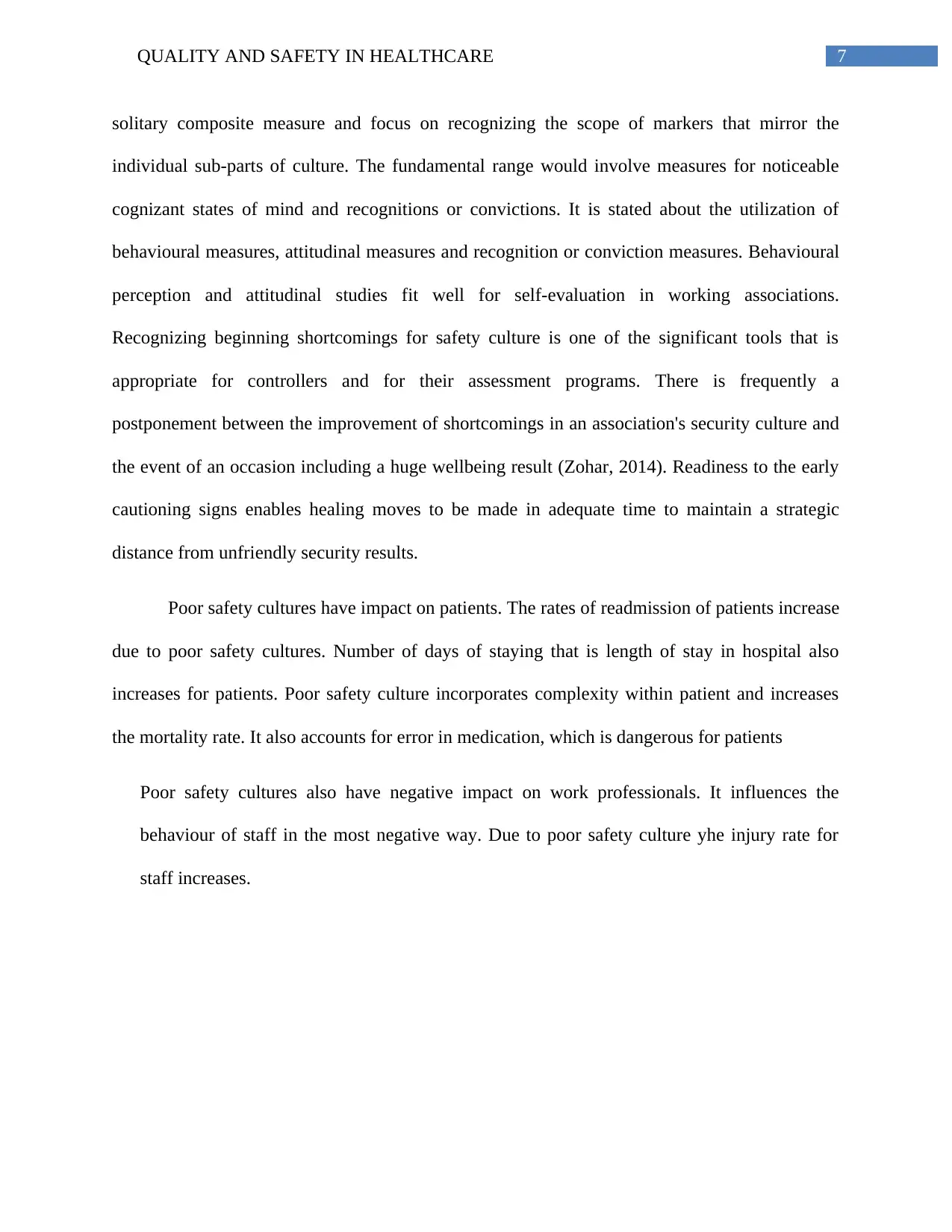
7QUALITY AND SAFETY IN HEALTHCARE
solitary composite measure and focus on recognizing the scope of markers that mirror the
individual sub-parts of culture. The fundamental range would involve measures for noticeable
cognizant states of mind and recognitions or convictions. It is stated about the utilization of
behavioural measures, attitudinal measures and recognition or conviction measures. Behavioural
perception and attitudinal studies fit well for self-evaluation in working associations.
Recognizing beginning shortcomings for safety culture is one of the significant tools that is
appropriate for controllers and for their assessment programs. There is frequently a
postponement between the improvement of shortcomings in an association's security culture and
the event of an occasion including a huge wellbeing result (Zohar, 2014). Readiness to the early
cautioning signs enables healing moves to be made in adequate time to maintain a strategic
distance from unfriendly security results.
Poor safety cultures have impact on patients. The rates of readmission of patients increase
due to poor safety cultures. Number of days of staying that is length of stay in hospital also
increases for patients. Poor safety culture incorporates complexity within patient and increases
the mortality rate. It also accounts for error in medication, which is dangerous for patients
Poor safety cultures also have negative impact on work professionals. It influences the
behaviour of staff in the most negative way. Due to poor safety culture yhe injury rate for
staff increases.
solitary composite measure and focus on recognizing the scope of markers that mirror the
individual sub-parts of culture. The fundamental range would involve measures for noticeable
cognizant states of mind and recognitions or convictions. It is stated about the utilization of
behavioural measures, attitudinal measures and recognition or conviction measures. Behavioural
perception and attitudinal studies fit well for self-evaluation in working associations.
Recognizing beginning shortcomings for safety culture is one of the significant tools that is
appropriate for controllers and for their assessment programs. There is frequently a
postponement between the improvement of shortcomings in an association's security culture and
the event of an occasion including a huge wellbeing result (Zohar, 2014). Readiness to the early
cautioning signs enables healing moves to be made in adequate time to maintain a strategic
distance from unfriendly security results.
Poor safety cultures have impact on patients. The rates of readmission of patients increase
due to poor safety cultures. Number of days of staying that is length of stay in hospital also
increases for patients. Poor safety culture incorporates complexity within patient and increases
the mortality rate. It also accounts for error in medication, which is dangerous for patients
Poor safety cultures also have negative impact on work professionals. It influences the
behaviour of staff in the most negative way. Due to poor safety culture yhe injury rate for
staff increases.
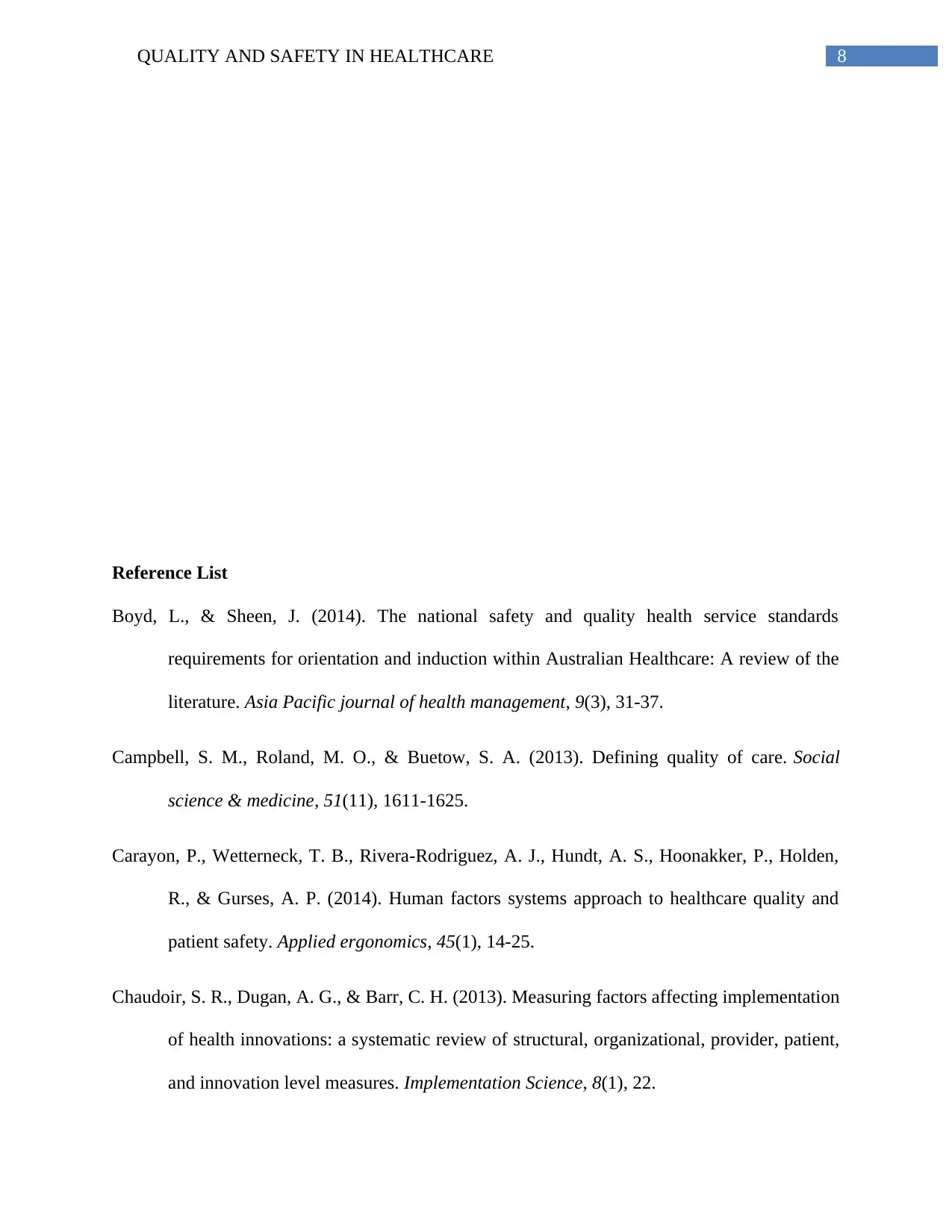
8QUALITY AND SAFETY IN HEALTHCARE
Reference List
Boyd, L., & Sheen, J. (2014). The national safety and quality health service standards
requirements for orientation and induction within Australian Healthcare: A review of the
literature. Asia Pacific journal of health management, 9(3), 31-37.
Campbell, S. M., Roland, M. O., & Buetow, S. A. (2013). Defining quality of care. Social
science & medicine, 51(11), 1611-1625.
Carayon, P., Wetterneck, T. B., Rivera-Rodriguez, A. J., Hundt, A. S., Hoonakker, P., Holden,
R., & Gurses, A. P. (2014). Human factors systems approach to healthcare quality and
patient safety. Applied ergonomics, 45(1), 14-25.
Chaudoir, S. R., Dugan, A. G., & Barr, C. H. (2013). Measuring factors affecting implementation
of health innovations: a systematic review of structural, organizational, provider, patient,
and innovation level measures. Implementation Science, 8(1), 22.
Reference List
Boyd, L., & Sheen, J. (2014). The national safety and quality health service standards
requirements for orientation and induction within Australian Healthcare: A review of the
literature. Asia Pacific journal of health management, 9(3), 31-37.
Campbell, S. M., Roland, M. O., & Buetow, S. A. (2013). Defining quality of care. Social
science & medicine, 51(11), 1611-1625.
Carayon, P., Wetterneck, T. B., Rivera-Rodriguez, A. J., Hundt, A. S., Hoonakker, P., Holden,
R., & Gurses, A. P. (2014). Human factors systems approach to healthcare quality and
patient safety. Applied ergonomics, 45(1), 14-25.
Chaudoir, S. R., Dugan, A. G., & Barr, C. H. (2013). Measuring factors affecting implementation
of health innovations: a systematic review of structural, organizational, provider, patient,
and innovation level measures. Implementation Science, 8(1), 22.
⊘ This is a preview!⊘
Do you want full access?
Subscribe today to unlock all pages.

Trusted by 1+ million students worldwide
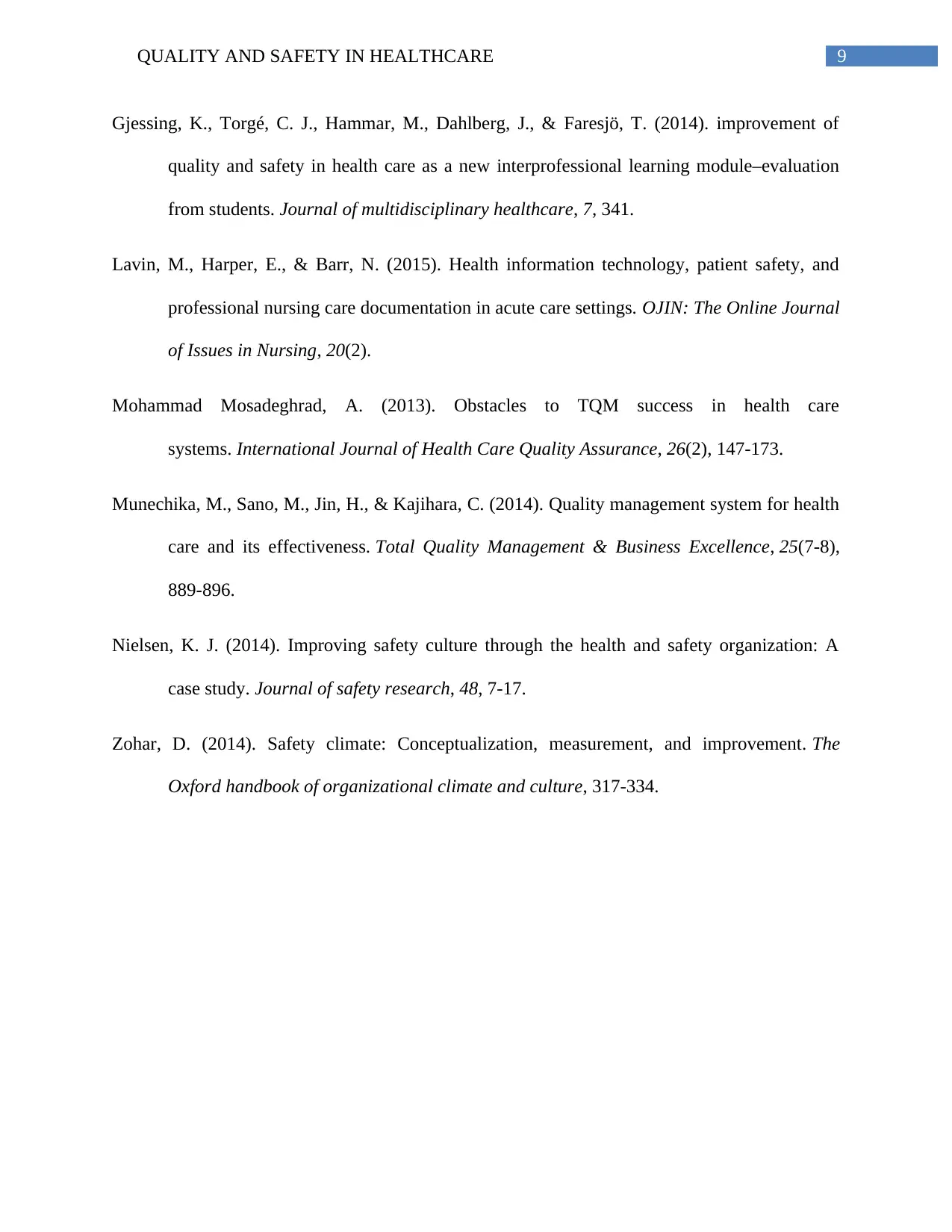
9QUALITY AND SAFETY IN HEALTHCARE
Gjessing, K., Torgé, C. J., Hammar, M., Dahlberg, J., & Faresjö, T. (2014). improvement of
quality and safety in health care as a new interprofessional learning module–evaluation
from students. Journal of multidisciplinary healthcare, 7, 341.
Lavin, M., Harper, E., & Barr, N. (2015). Health information technology, patient safety, and
professional nursing care documentation in acute care settings. OJIN: The Online Journal
of Issues in Nursing, 20(2).
Mohammad Mosadeghrad, A. (2013). Obstacles to TQM success in health care
systems. International Journal of Health Care Quality Assurance, 26(2), 147-173.
Munechika, M., Sano, M., Jin, H., & Kajihara, C. (2014). Quality management system for health
care and its effectiveness. Total Quality Management & Business Excellence, 25(7-8),
889-896.
Nielsen, K. J. (2014). Improving safety culture through the health and safety organization: A
case study. Journal of safety research, 48, 7-17.
Zohar, D. (2014). Safety climate: Conceptualization, measurement, and improvement. The
Oxford handbook of organizational climate and culture, 317-334.
Gjessing, K., Torgé, C. J., Hammar, M., Dahlberg, J., & Faresjö, T. (2014). improvement of
quality and safety in health care as a new interprofessional learning module–evaluation
from students. Journal of multidisciplinary healthcare, 7, 341.
Lavin, M., Harper, E., & Barr, N. (2015). Health information technology, patient safety, and
professional nursing care documentation in acute care settings. OJIN: The Online Journal
of Issues in Nursing, 20(2).
Mohammad Mosadeghrad, A. (2013). Obstacles to TQM success in health care
systems. International Journal of Health Care Quality Assurance, 26(2), 147-173.
Munechika, M., Sano, M., Jin, H., & Kajihara, C. (2014). Quality management system for health
care and its effectiveness. Total Quality Management & Business Excellence, 25(7-8),
889-896.
Nielsen, K. J. (2014). Improving safety culture through the health and safety organization: A
case study. Journal of safety research, 48, 7-17.
Zohar, D. (2014). Safety climate: Conceptualization, measurement, and improvement. The
Oxford handbook of organizational climate and culture, 317-334.
1 out of 10
Related Documents
Your All-in-One AI-Powered Toolkit for Academic Success.
+13062052269
info@desklib.com
Available 24*7 on WhatsApp / Email
![[object Object]](/_next/static/media/star-bottom.7253800d.svg)
Unlock your academic potential
Copyright © 2020–2025 A2Z Services. All Rights Reserved. Developed and managed by ZUCOL.



